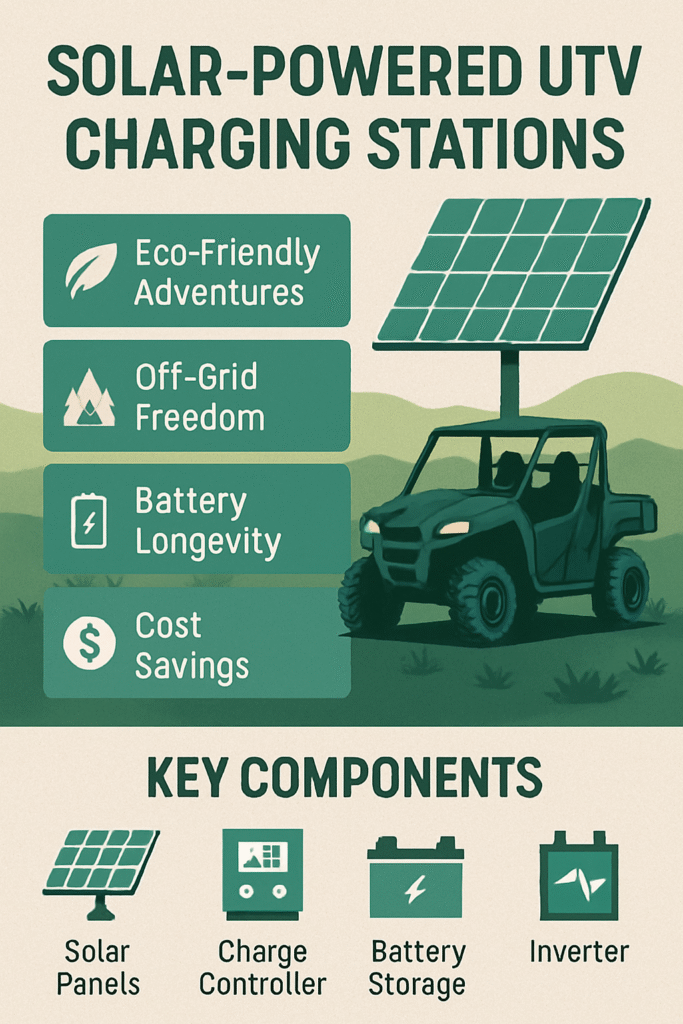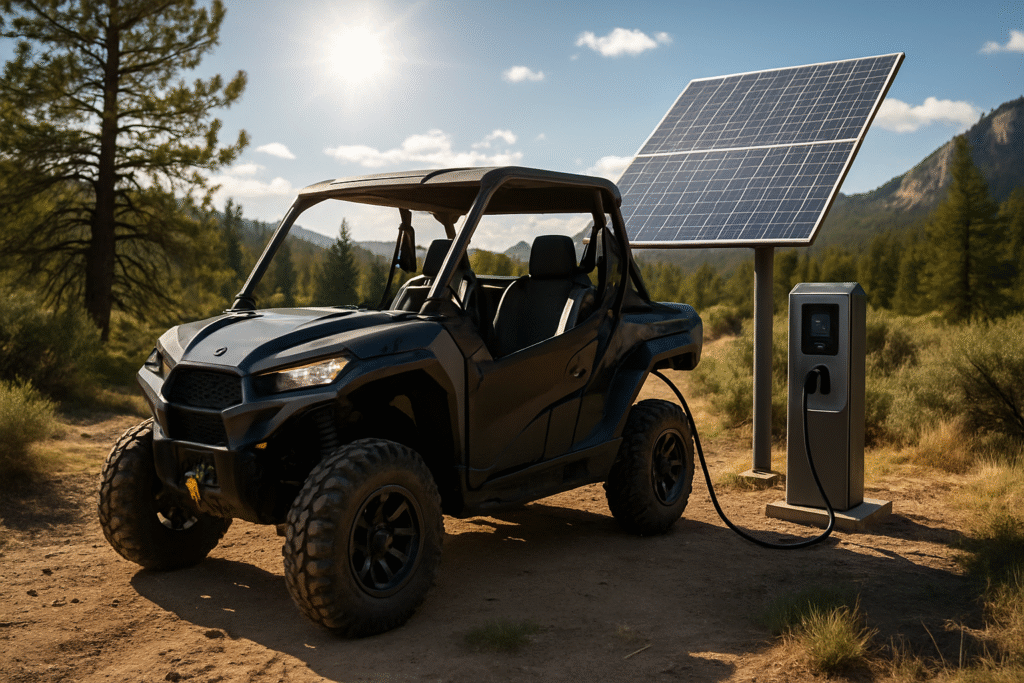Hey fellow off-road enthusiasts! Have you ever been deep in the wilderness, enjoying the thrill of your UTV, only to start worrying about your battery life?
Or perhaps you’re looking for ways to make your outdoor adventures more sustainable?
Well, get ready to have your mind blown, because solar-powered UTV charging stations are here to revolutionize how we explore!
This isn’t just about convenience; it’s about embracing a greener, more self-sufficient way to keep our UTVs roaring (or silently humming, if you’re rocking an electric model!).
Let’s dive into the exciting world of off-grid solar charging and discover how it’s changing the game for UTV owners everywhere.
Why Go Solar for Your UTV? The Unbeatable Benefits
When we talk about solar power, we’re not just talking about saving a few bucks on your electricity bill (though that’s a nice bonus!).
For UTVs, especially electric models, solar charging offers a unique set of advantages that truly enhance the off-road experience.

Videos are added as random thoughts 💭 💭 💭.
Imagine extending your range without being tethered to the grid, or maintaining your battery health even during long periods of inactivity. It’s all possible with the power of the sun.
1. Eco-Friendly Adventures
One of the most compelling reasons to embrace solar UTV charging is its environmental impact.
By harnessing the sun’s energy, you’re reducing your reliance on fossil fuels and minimizing your carbon footprint.
This means cleaner air and a healthier planet for all of us to enjoy our outdoor escapades.
It’s a win-win: thrilling adventures and environmental stewardship go hand-in-hand [1].
2. Off-Grid Freedom and Extended Range
This is where solar truly shines for UTV owners.
Traditional charging methods require access to an electrical outlet, which can be a major limitation when you’re far from civilization.
Solar charging stations, whether portable or fixed in remote locations, provide the ultimate off-grid freedom.
Companies like Yotta Energy have even partnered with Polaris to deploy remote, solar-powered charging stations along hundreds of miles of trails in Michigan’s Upper Peninsula, giving EV off-roaders places to plug in where they never could before [2].
This means longer rides, more exploration, and less range anxiety.
3. Battery Health and Longevity
Even if you’re not constantly out on the trails, solar power can play a crucial role in maintaining your UTV’s battery.
Battery maintainer solar chargers are designed to trickle charge your battery, preventing drain and prolonging its lifespan, especially during the off-season or periods of inactivity [3].
This not only saves you money on battery replacements but also ensures your UTV is always ready for action when you are.
4. Cost Savings and Energy Independence
While there’s an initial investment, charging your UTV directly from solar power can significantly reduce your long-term energy costs.
Once installed, the sun’s energy is essentially free.
This leads to greater energy independence, freeing you from fluctuating electricity prices and the need to find grid connections in remote areas [4].
What Makes a Solar UTV Charging Station Tick? Key Components
So, how does this magic happen?
A solar UTV charging station, whether a simple battery maintainer or a full-fledged off-grid system, relies on several key components working in harmony.
Understanding these parts can help you appreciate the technology and even consider a DIY setup.
1. Solar Panels
These are the stars of the show! Solar panels capture sunlight and convert it into direct current (DC) electricity.
The size and number of panels will depend on the charging speed and capacity you need.
For UTVs, you might see anything from small, portable panels for trickle charging to larger arrays for faster charging of electric UTVs [5].
2. Charge Controller
Think of the charge controller as the brain of the system.
It regulates the voltage and current coming from the solar panels to prevent overcharging your UTV’s battery.
This is crucial for battery health and safety, ensuring a stable and efficient charge [5].
3. Battery Storage (Optional, but Recommended for Off-Grid)
For true off-grid capability, battery storage is essential.
This allows the system to store excess solar energy generated during the day for use at night or on cloudy days.
For UTV charging stations, these could be dedicated battery banks that then supply power to the UTV charger [5].
4. Inverter (for AC Charging)
If your UTV charger requires alternating current (AC) power (like most standard wall chargers), an inverter is needed.
The inverter converts the DC electricity from the solar panels or battery bank into AC electricity that your UTV charger can use [5].
Some UTVs might have DC charging capabilities, simplifying the system.
5. EVSE (Electric Vehicle Supply Equipment) / Charging Dock
This is the actual interface that connects to your UTV.
For electric UTVs, this would be similar to an EV charging station, providing the necessary power to recharge the vehicle [5].
How Much Does a Solar UTV Charging Station Cost?
The cost of a solar UTV charging station can vary widely depending on its complexity, capacity, and whether it’s a portable solution or a permanent installation.
It’s important to differentiate between a simple battery maintainer and a full-scale charging station capable of rapidly recharging an electric UTV.
Battery Maintainer Solar Chargers
For maintaining the battery of a gas-powered UTV or trickle charging a smaller electric UTV battery,
a battery maintainer solar charger can be quite affordable, often ranging from $50 to $200.
These typically include a small solar panel and a charge controller, designed for long-term battery health rather than rapid charging.
Dedicated UTV Charging Stations
When it comes to dedicated charging stations for electric UTVs, the costs can be higher, reflecting the greater power output and storage capabilities.
These systems are more akin to electric vehicle (EV) charging stations.
For a Level 2 charger, which is common for home and public EV charging, the equipment and installation can range from $1,000 to $5,000 [6].
However, integrating this with a solar array will add to the cost, depending on the size of the solar panels and battery storage needed.
Commercial-grade solar EV charging stations, especially those with DC fast charging capabilities, can run into the tens of thousands, or even hundreds of thousands of dollars, depending on the number of charging ports and battery storage capacity [7].
Factors Influencing Cost:
Solar Panel Wattage: Higher wattage panels generate more power but cost more.
Battery Storage Capacity: Larger battery banks for off-grid use increase costs.
Inverter Size: Needed if converting DC to AC for charging.
Charger Type: Level 1, Level 2, or DC Fast Charger (for electric UTVs).
Installation: DIY versus professional installation.
Portability vs. Permanent: Portable solutions are generally less expensive and more flexible.
DIY Solar UTV Charging: Is It for You?
For the mechanically inclined and budget-conscious, building a DIY solar UTV charging station can be a rewarding project.
It allows for customization to your specific needs and can significantly reduce overall costs.
Many resources, like online forums and YouTube tutorials, offer guidance for various setups, from simple battery tenders to more robust portable power stations [8, 9].
What You’ll Need for a Basic DIY Setup:
1. Solar Panel: Choose a panel size based on your charging needs. A 50W panel might be sufficient for maintaining a UTV battery [10].
2. Charge Controller: Essential for protecting your battery from overcharging.
3. Battery: A deep-cycle battery (like a marine battery) to store solar energy.
4. Wiring and Connectors: Appropriate gauges and types for your system.
5. Enclosure: To protect components from the elements, especially for outdoor use.
Remember, safety is paramount when working with electrical systems. If you’re unsure, it’s always best to consult with a professional or opt for pre-built solutions.
The Future is Bright: Embracing Solar for UTV Adventures
Solar-powered UTV charging stations are more than just a niche product; they represent a significant step towards sustainable and independent off-road exploration.
From extending your range in remote areas to ensuring your battery is always ready, the benefits are clear.
As technology advances and costs potentially decrease, we can expect to see even more innovative and accessible solar charging solutions for UTVs.
So, whether you’re a seasoned off-roader looking to upgrade your setup or a newcomer to the UTV world, consider the power of the sun.
It’s an investment in longer adventures, a healthier planet, and the freedom to explore without limits.
Get ready to power up your UTV with sunshine and hit the trails with confidence!
References
[1] Benefits of Using a Solar EV Charger. Empower Solar.
[2] Polaris Project Gives EV Off-Roaders Places To Plug In. Yotta Energy. [
[3] UTV and ATV Battery Maintenance with Solar. Zamp Solar







